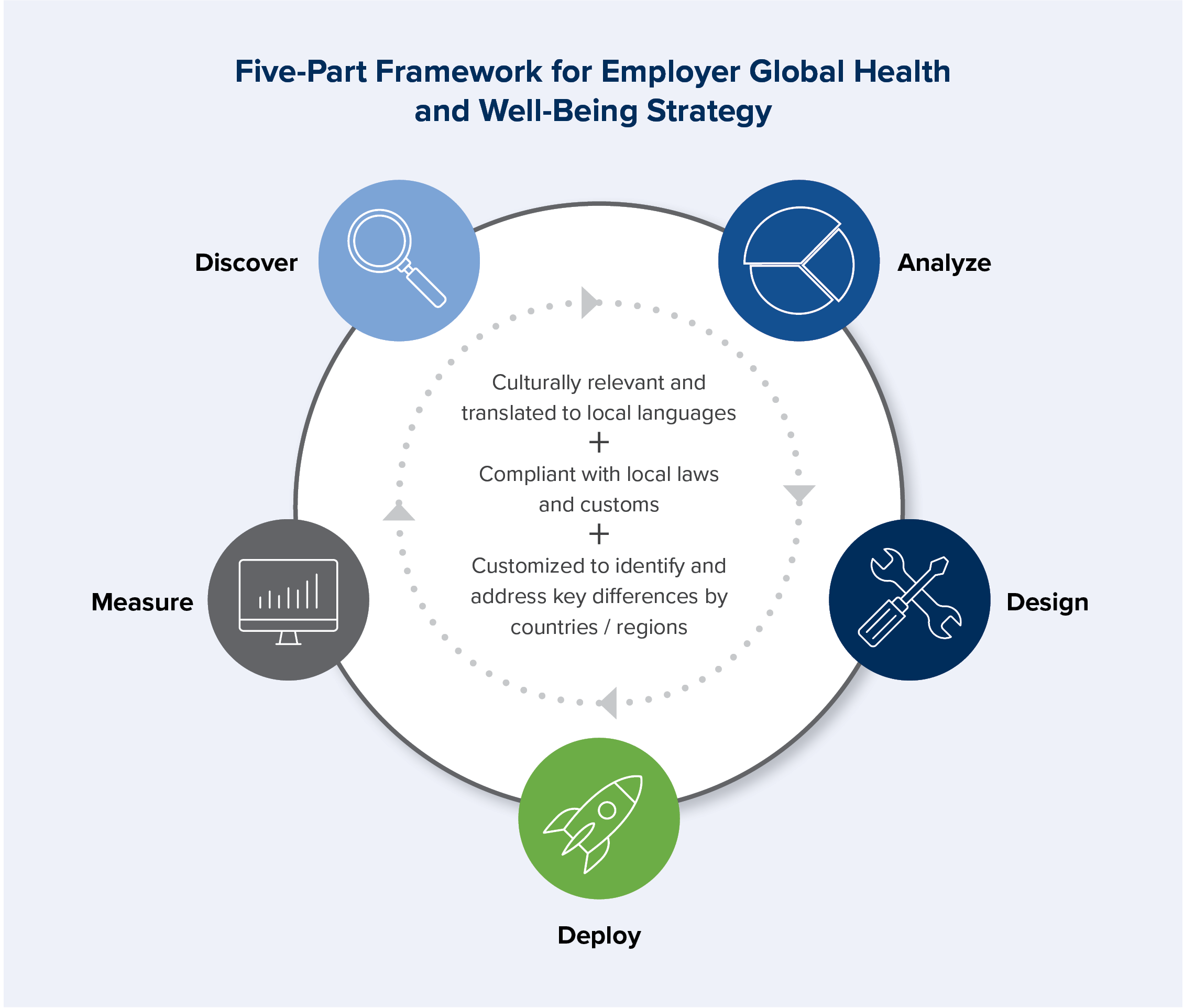A Sustainable Employer Framework for Effective Global Health & Well-Being Strategies
Employee Benefits
A Sustainable Employer Framework for Effective Global Health & Well-Being Strategies
Considering worldwide events and trends like a global pandemic, socio-economic volatility, geo-political conflict and rising rates of chronic health conditions, supporting the well-being of global employees has become a top priority for multi-national organizations. In a 2023 survey of global employers, 80% reported they have or are developing a globally consistent well-being strategy1, a significant upward trend and a shift compared to prior years.
Before developing such strategies, employers need to understand the macro challenges and trends influencing the need for effective global well-being plans and outcomes.
We believe the following FIVE macro challenges and trends are driving the increased need for employers to focus on global well-being as a top priority:
- COVID-19 disrupted global rates of well-being, particularly mental health: the pandemic led to a 27.6% increase in depression and a 25.6% increase in anxiety globally.2 In another global survey of employees in 2022, only 44% rated their well-being positively, while 73% reported moderate to high levels of stress3.
- Rising rates of obesity and metabolic disease: worldwide obesity has tripled since 1975, and most of the world’s population now lives in countries where being overweight kills more people than underweight.4 This has contributed to a global increase in chronic conditions, including diabetes.
- A competitive talent landscape: according to a 2023 study, 77% of global employers report difficulty filling open roles – a record 17-year high.5 This reality also tracks with global employee sentiment, as 6 in 10 are considering leaving their current employer.3
- Exponential growth in global health venture funding and innovation: the ten years from 2012 to 2021 delivered exponential growth in funding for digital and virtual health solutions ($1.6B compared to $29.3B for 2012 and 2021, respectively). Although funding decreased in 2022 to $15.3B, employer interest in the sustainable deployment of innovative health solutions remains high6.
- Vocal employee sentiment and greater expectations around well-being support: only one in three (34%) of employees say their employers care about their well-being, and a similarly small percentage (35%) say their company’s well-being programs are attractive to new employees3. Employee sentiment around well-being support is also closely linked to perspectives around the organization’s support for Diversity, Equity, Inclusion and Belonging (DEIB).
Given these challenges, employers should adopt a sustainable framework that can be iterative and refreshed to deliver an effective and adaptable global health and well-being strategy.
Brown & Brown has developed a five-part framework for employers and their global health and well-being strategy. The framework relies on the following employer actions:

I. Discover
- Understand the current state of governance infrastructure supporting the administration and delivery of global health benefits and well-being programs
- Conduct inventory of programs, resources and benefits
- Utilize stakeholder interviews to document challenges and priorities
II. Analyze
- Examine data on employee sentiment, preferences, lifestyle and clinical risks
- Capture snapshot of financial investment and budgets related to health spend
III. Design
- Develop a conceptual framework, guiding principles and strategic roadmap of priorities
- Outline communications and measurement plans
IV. Deploy
- Establish or reassess global minimum standards
- Develop or re-energize a well-being champions network
- Engage with high-performing vendor solutions with global capabilities
- Accommodate local limitations (health care delivery systems, data availability, etc.)
- Connect with local welfare and social programs
V. Measure
- Determine the impact of interventions on employee sentiment, lifestyle and clinical risk
- Track financial investment and value of return
- Monitor vendor delivery and performance guarantees
No matter where employers are in their global health and well-being journey, the approach above will assist in refreshing or developing a sustainable and iterative roadmap to help lead to the success of global health and well-being strategies and business. This iterative approach could help yield better health outcomes and improved business metrics, including productivity, engagement, talent attraction, retention and employee satisfaction.
1. 14th Annual Employer-Sponsored Health & Well-being Survey from Fidelity Investments and Business Group on Health, 2023; https://businessgrouphealth.org/en/newsroom/news%20and%20press%20releases/press%20releases/2023%20fidelity%20survey
2. Taquet M, Holmes EA, Harrison PJ. Depression and anxiety disorders during the COVID-19 pandemic: knowns and unknowns. Lancet. 2021 Nov 6;398(10312):1665-1666. doi: 10.1016/S0140-6736(21)02221-2. Epub 2021 Oct 8. PMID: 34634251; PMCID: PMC9754944. Retrieved August 2023 from: https://www.ncbi.nlm.nih.gov/pmc/articles/PMC9754944/
3. 2022 Alight International Workforce and Wellbeing Mindset Report; https://www.alight.com/getmedia/3a2d9f36-fe6a-429e-94ca-faca65db9811/2022-Alight-internationalworkforce-and-wellbeing-mindset-study_1.pdf
4. World Health Organization, Obesity and Overweight, Retrieved August 2023 from: https://www.who.int/news-room/fact-sheets/detail/obesity-and-overweight
5. The ManPower Group, The Talent Shortage, Retrieved August 2023 from: https://go.manpowergroup.com/talent-shortage
6. CB Insights State of Digital Health 2021 and 2022 Reports: https://www.cbinsights.com/research/report/digital-health-trends-2021/ and https://www.cbinsights.com/research/report/digital-health-trends-2022/

Abinue Fortingo, MPH
Principal, Population Health and Well-Being Consultant

Louise Short, MD, MSc
National Clinical Leader
